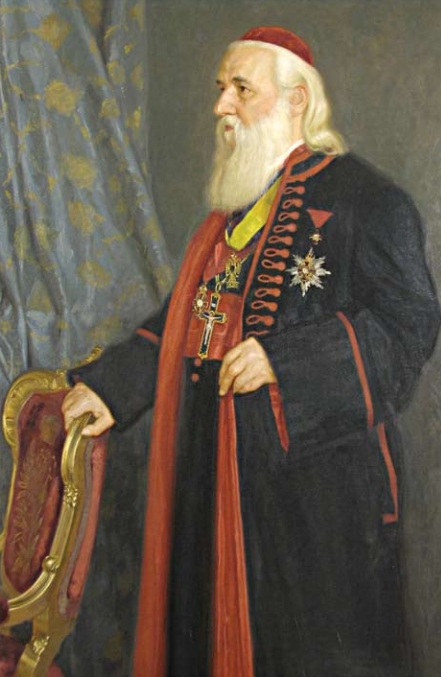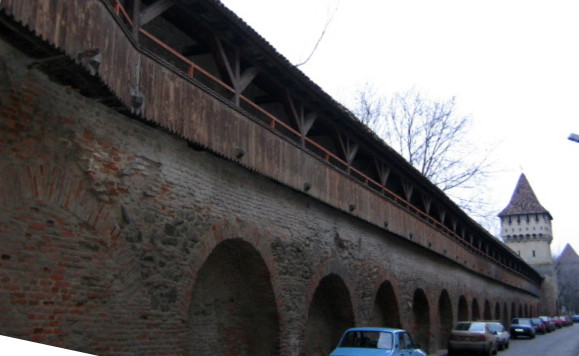|
Bishopric Of Arad, Ienopole And Hălmagiu
The Archdiocese or Archbishopric of Arad (), formerly the Bishopric of Arad (, ) is an episcopal see of the Romanian Orthodox Church, under the administration of the Metropolis of Banat, with jurisdiction over Arad County in Romania. The current head is bishop Timotei (Seviciu), Timotei Seviciu. History The history of Eastern Orthodox Christianity on the territory of the present-day bishopric dates back to late Antiquity and early Middle Ages. During the later medieval periods, authorities of the Kingdom of Hungary had an ambivalent attitude towards the presence of Eastern Orthodox Christians in southern and eastern regions of the realm. During the period of the Ottoman Empire, Ottoman rule, from the middle of the 16th century to the end of the 17th century, the region of Arad was under ecclesiastical jurisdiction of the Serbian Patriarchate of Peć. The Eparchy of Arad in its modern form was created after the Great Turkish War (1683-1699), when the city of Arad and its region b ... [...More Info...] [...Related Items...] OR: [Wikipedia] [Google] [Baidu] |
Arad, Romania
Arad () is the capital city of Arad County, at the edge of Crișana and Banat. No villages are administered by the city. It is the third largest city in Western Romania, behind Timișoara and Oradea, and the List of cities and towns in Romania, 12th largest in Romania, with a population of 145,078. A busy transportation hub on the Mureș River and an important cultural and industrial center, Arad has hosted one of the first Music school, music conservatories in Europe, one of the earliest normal schools in Europe, and the first car factory in Hungary and present-day Romania. Today, it is the seat of a Romanian Orthodox Church, Romanian Orthodox archbishop and features a Romanian Orthodox theological seminary and two universities. The city's multicultural heritage is owed to the fact that it has been part of the Kingdom of Hungary, the Eastern Hungarian Kingdom, the Ottoman Empire, Ottoman Temeşvar Eyalet, Principality of Transylvania (1570–1711), Principality of Transylvania, ... [...More Info...] [...Related Items...] OR: [Wikipedia] [Google] [Baidu] |
Serbs
The Serbs ( sr-Cyr, Срби, Srbi, ) are a South Slavs, South Slavic ethnic group native to Southeastern Europe who share a common Serbian Cultural heritage, ancestry, Culture of Serbia, culture, History of Serbia, history, and Serbian language, language. They primarily live in Serbia, Kosovo, Bosnia and Herzegovina, Croatia, Montenegro as well as in North Macedonia, Slovenia, Germany and Austria. They also constitute a significant diaspora with several communities across Europe, the Americas and Oceania. The Serbs share many cultural traits with the rest of the peoples of Southeast Europe. They are predominantly Eastern Orthodoxy, Eastern Orthodox Christians by religion. The Serbian language, Serbian language (a standardized version of Serbo-Croatian) is official in Serbia, co-official in Kosovo and Bosnia and Herzegovina, and is spoken by the plurality in Montenegro. Ethnology The identity of Serbs is rooted in Eastern Orthodoxy and traditions. In the 19th century, the ... [...More Info...] [...Related Items...] OR: [Wikipedia] [Google] [Baidu] |
Vikentije Jovanović
Vikentije Jovanović ( sr-cyr, Викентије Јовановић; 1689 – 6 June 1737) was the Serbian Orthodox Metropolitan of Belgrade and Karlovci from 1731 to 1737, as Vikentije II. During his diplomatic mission in Vienna in 1734, he was given permission by Emperor Charles VI to establish a hussar regiment constituted solely of Serbs and Croats. It was officially named ''Illyrian-Rascian regiment'' and inaugurated on 16 June 1735 in a grand ceremony officiated by Vikentije. The ceremony took place outside Budim where the banners which were used symbolized his importance in the Austrian Empire, but also the dual symbolism of East and West; dual coats of arms on their spears, two languages in their inscriptions (Church Slavonic and Latin), and the use of Eastern iconography and Western emblematic imagery. Vikentije's hussars went on to fight in the Austro-Russian–Turkish War (1735–1739). Annotations ). See also * Metropolitanate of Karlovci * List of heads of ... [...More Info...] [...Related Items...] OR: [Wikipedia] [Google] [Baidu] |
World War I
World War I or the First World War (28 July 1914 – 11 November 1918), also known as the Great War, was a World war, global conflict between two coalitions: the Allies of World War I, Allies (or Entente) and the Central Powers. Fighting took place mainly in European theatre of World War I, Europe and the Middle Eastern theatre of World War I, Middle East, as well as in parts of African theatre of World War I, Africa and the Asian and Pacific theatre of World War I, Asia-Pacific, and in Europe was characterised by trench warfare; the widespread use of Artillery of World War I, artillery, machine guns, and Chemical weapons in World War I, chemical weapons (gas); and the introductions of Tanks in World War I, tanks and Aviation in World War I, aircraft. World War I was one of the List of wars by death toll, deadliest conflicts in history, resulting in an estimated World War I casualties, 10 million military dead and more than 20 million wounded, plus some 10 million civilian de ... [...More Info...] [...Related Items...] OR: [Wikipedia] [Google] [Baidu] |
Eparchy Of Vršac
The Eparchy of Banat () is an eparchy (diocese) of the Serbian Orthodox Church in the Banat region, Serbia. It is mostly situated in eastern parts of the autonomous province of Vojvodina, while the eparchy also includes a small south-western part of Banat that belongs to the City of Belgrade as well as village of Ostrovo that belongs to the city of Požarevac. The seat of the eparchy is in Vršac. History During the middle ages, entire territory of modern Serbian Banat belonged to the Kingdom of Hungary, that had ambivalent attitudes towards the presence of Eastern Orthodox Christianity in its southern and eastern regions, depending on relations with the Byzantine Empire, and medieval Serbia. By the end of the 15th century, Serbian presence in those regions was significantly enlarged by continuous migrations that were caused by Ottoman invasion of Serbian lands. The Serbian Orthodox Eparchy of Vršac was one of several eparchies created on the territory of Banat during th ... [...More Info...] [...Related Items...] OR: [Wikipedia] [Google] [Baidu] |
Eparchy Of Temišvar
The Eparchy of Temišvar ( or ) is a diocese or eparchy of the Serbian Orthodox Church, having jurisdiction over the territory of Romania. The see of the eparchy is in Timișoara ( or ). Bishops List of Serbian Orthodox Bishops of Temišvar: * Neofit (1608); * Isaija (1640); * Josif (1643); * Teodor (1643); * Sevastijan (1644, 1647); * Mihajl (1681—1687); * Vasilije (1688); * Josif II (1688); * Vasilije (1693); * Isaija Đaković (1695—1710); * Konstantin Grk (1704-1713); * Joanikije Vladisavljević (1713-1727); * Nikola Dimitrijević (1728-1744); * Georgije Popović (1745-1757); * Vikentije Jovanović-Vidak (1759-1774); * Mojsej Putnik (1774-1781); * Sofronije Kirilović (1781-1786); * Petar Petrović (1786-1800); * Stefan Avakumović (1801-1822); * Josif Putnik (1829-1830); * Maksim Manulović (1833-1838); * Pantelejmon Živković (1839-1851); * Samuilo Maširević (1853-1864); * Antonije Nako (1864-1869); * Georgije Vojnović (1874-1881); * Georgije Branković ( ... [...More Info...] [...Related Items...] OR: [Wikipedia] [Google] [Baidu] |
Eparchy Of Arad
The Archdiocese or Archbishopric of Arad (), formerly the Bishopric of Arad (, ) is an episcopal see of the Romanian Orthodox Church, under the administration of the Metropolis of Banat, with jurisdiction over Arad County in Romania. The current head is bishop Timotei Seviciu. History The history of Eastern Orthodox Christianity on the territory of the present-day bishopric dates back to late Antiquity and early Middle Ages. During the later medieval periods, authorities of the Kingdom of Hungary had an ambivalent attitude towards the presence of Eastern Orthodox Christians in southern and eastern regions of the realm. During the period of the Ottoman rule, from the middle of the 16th century to the end of the 17th century, the region of Arad was under ecclesiastical jurisdiction of the Serbian Patriarchate of Peć. The Eparchy of Arad in its modern form was created after the Great Turkish War (1683-1699), when the city of Arad and its region became part of the Habsburg monarc ... [...More Info...] [...Related Items...] OR: [Wikipedia] [Google] [Baidu] |
Sibiu
Sibiu ( , , , Hungarian: ''Nagyszeben'', , Transylvanian Saxon: ''Härmeschtat'' or ''Hermestatt'') is a city in central Romania, situated in the historical region of Transylvania. Located some north-west of Bucharest, the city straddles the Cibin River, a tributary of the Olt River. Now the seat of Sibiu County, between 1692 and 1791 and 1849–65 Sibiu was the capital of the Principality of Transylvania. Until 1876, the Hecht hause in Sibiu served as the seat of the Transylvanian Saxon University. Nicknamed ''The Town with Eyes'' for the eyebrow dormers on many old buildings, the town is a popular tourist destination. It is known for its culture, history, cuisine, and architecture. In 2004, its historical center was added to the tentative list of UNESCO World Heritage Sites. Sibiu was subsequently designated the European Capital of Culture in 2007, along with Luxembourg City. One year later, it was ranked "Europe's 8th-most idyllic place to live" by ''Forbes''. Sibi ... [...More Info...] [...Related Items...] OR: [Wikipedia] [Google] [Baidu] |
Metropolis Of Sibiu
A metropolis () is a large city or conurbation which is a significant economic, political, and cultural area for a country or region, and an important hub for regional or international connections, commerce, and communications. A big city belonging to a larger urban agglomeration, but which is not the core of that agglomeration, is not generally considered a metropolis but a part of it. The plural of the word is ''metropolises'', although the Latin plural is , from the Greek (). For urban areas outside metropolitan areas that generate a similar attraction on a smaller scale for their region, the concept of the regiopolis ("regio" for short) was introduced by urban and regional planning researchers in Germany in 2006. Etymology () is a Greek word, (plural: ) coming from , meaning "mother" and , meaning "city" or "town", which is how the Greek colonies of antiquity referred to their original cities, with whom they retained cultic and political-cultural connections. The wo ... [...More Info...] [...Related Items...] OR: [Wikipedia] [Google] [Baidu] |




